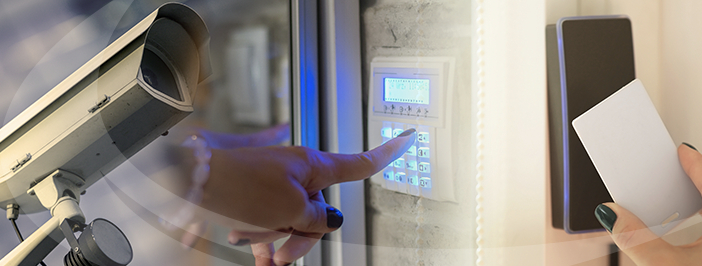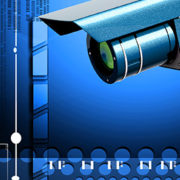Is Your Security System Physically Protecting Your Organization?
When most people think of security for their business, their first thought these days tends to be about cybersecurity. And rightly so – the average cost of data breaches has jumped to $4 million, a 29% increase since 2013.
Costs will continue to scale with the mounting creation of business data around the world. However, it’s important not to put all your eggs in the “cybersecurity” basket.
Physical security is still equally important to securing data, despite the fact that it gets far less news coverage. Having an effective physical security system in place can offer protection that is measurably valuable in its own right.

Source: Fortune
The Importance of Physical Security
Firewalls, antivirus programs, and other commercial-grade network security solutions are all great ways to protect a company’s IT infrastructure. However, organizations must take physical security measures to protect their assets. That includes protection of the servers, computers, phones, employees, and more that represent your local, remote and mobile workplace.
One of the most effective tools for enhancing physical security is on-premise video surveillance. Video surveillance systems allow companies to reduce the loss of property resulting from theft and vandalism, while also promoting a safer work environment.
Additionally, video surveillance keeps people honest and the business accountable. The presence of security cameras and awareness of being monitored affects people’s behavioral patterns and habits. The benefits for the business can include reduced insurance costs, fewer frivolous lawsuits, and even keeping employees productive.
In fact, this extra measure of protection and accountability can also have the positive effect of increasing trust with employees and even customers because they see that the company values security and transparency for everyone.
Focusing on Data Exfiltration
While most security studies focus solely on infiltration – such as how hackers are getting past network security defenses – security-conscious companies should put a great deal more focus on exfiltration.
Exfiltration, in the sense of data and network security, is how attackers are able to remove critical data and valuable company information in the first place. There’s an incredible amount of exfiltration risk within organizations that often goes undetected. According to a 2015 study from the Ponemon Institute, the biggest threat (78%) to data security is negligent or careless employees who don’t follow data security policies.
Most successful data exfiltration events involve transporting or even stealing physical devices of some kind, such as laptops and mobile devices. They also include mishandling and theft by downloading company data directly to a jump drive. And when crafty employees steal data, they find clever ways to cover their trail.
USB drives can easily be stolen for two reasons – because size and privacy matter. USBs are conveniently portable and small enough to easily be hidden on an employee’s body. However, physically searching each employee is unfeasible, and usually seen as a complete breach of their individual privacy.
Data taken off-site through other physical devices (such as laptops, tablets, and phones) is typically buried deep within hidden folders on the devices. Doing an exhaustive search for this concealment of data is also ultimately unfeasible.
How To Improve Your Physical Security
You may not be able to physically prevent employee-based data exfiltration, but proper security measures can greatly reduce the chances of it happening in the first place.
Companies can maintain effective physical security through the implementation of:
- Surveillance cameras
- Motion detectors
- ID badges or smart cards
- Mass alert systems
- Intrusion Detection Services (IDS)
There are three valuable options for enhancing your organization’s physical security.

Physical locks are vital for adhering to proper site security policies. But in the event of a break-in or lock failure, you’ll need other physical security measures in place to prevent unauthorized access to data and other workplace assets.
Monitoring the activity of your entire property does just that. Surveillance cameras placed in areas in hard-to-reach areas are difficult to disable or tamper with. Not only do they act as a deterrent for would-be security breaches, but they also record ample evidence of violations and perpetrators that you can pass on to the proper authorities.
Surveillance systems can also be equipped with motion sensors capable of triggering text or email alerts when activity is detected in specific protected areas.

Alarms and intrusion detection systems are considered a key element of physical security. They can connect to alert and response systems that quickly inform and activate emergency services if there’s ever an issue that requires immediate attention.

Implementing access control on company property is one of the most straightforward ways to manage who can access your property – and when. This can be accomplished by investing in ID cards for employees, with unique codes identifying each individual. No one is able to access entry points to your building without proper security credentials, and there’s no need to change locks on doors when an employee leaves the company. You can simply update the access control database to update permissions as needed.
 Physical Security Help from TFE
Physical Security Help from TFE
Ensuring that your company’s physical security is up-to-date and capable of protecting company assets should be a top priority. Though physical security is often overlooked, it’s still a critical part of any comprehensive security plan that should work hand-in-hand with your cybersecurity efforts.
If you’d like more information on how physical security solutions can help protect your business, feel free to contact us.




 Physical Security Help from TFE
Physical Security Help from TFE







